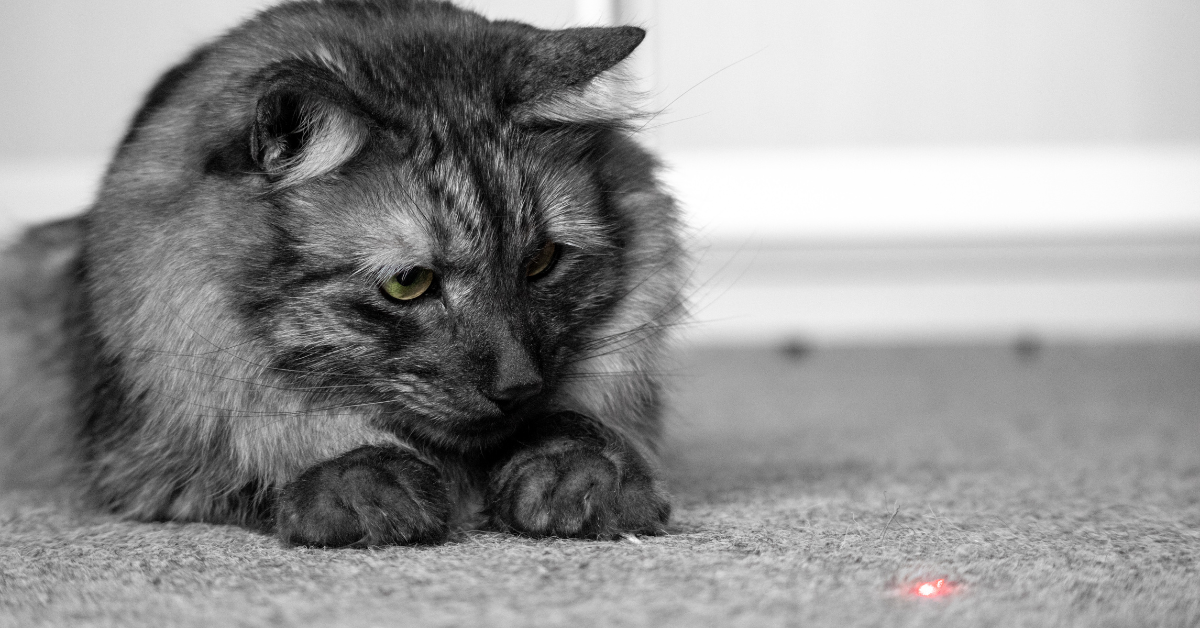There’s an old tired joke out there that describes what the beginning of a pet’s poem, to his owner, may sound like. It goes something like this: Roses are gray, Violets are gray, Everything is gray, I love you.
While certainly humorous, this joke is based on the age-old belief that both dogs and cats are color blind.
While recent research has shown that dogs can, in fact, see in color, the question remains: what about cats? Can our fuzzy friends distinguish the same range of colors that we do?
Or are their worlds slightly less dazzling to look at?
How Do Eyes See Color?
Eyes are able to interpret colors based off of light.

The retina has two types of photoreceptors, which are the cells that detect and respond to light. These photoreceptors are rods and cones. Rods are activated in low or dim light, while cones are stimulated in brighter environments.
Cones are what we’re interested in here. They contain color-detecting molecules, or photo pigments, that allow us to interpret colors. Humans typically have three types of photo pigments – red, green, and blue. Each type of color corresponds to different wavelengths of visible light.
So, when an orange reflects sunlight, the red and green cones are activated. Once activated, these cones send a signal along the optic nerve to the visual cortex of the brain. The brain then gets to work processing information such as the number of cones activated and the strength of their signal. You then interpret the color based off the information your brain just processed.
What is Color Blindness?

According to the National Eye Institute, red-green color blindness is most common, followed by blue-yellow color blindness. Contrary to popular belief, the ability to only see black and white, otherwise known as monochromatism, is incredibly uncommon.
Are Cats Colorblind?
A cat’s vision is similar to a human who is color blind.

Cats can see shades of blue and green, but, may have trouble perceiving true reds and pinks. Some scientists even believe that cats can only perceive blues and grays, while others think they can also see yellow.
How Are Cat Eyes Different From Human Eyes?
While humans might have a one-up on cats when it comes to color perception, cats have a huge VISUAL leg up on us! Remember how a retina’s cones are what give it the ability to interpret color? Well, a retina’s rods are what give it the power to detect movement in the dark and on the sides of your field of vision.

Additionally, cats have elliptical-shaped pupils which allows them to capture as much as light as possible when dilated. This allows them to need only one-sixth the amount of light that humans need to see an object. Also, cat eyes have a thin layer behind their retinas called the tapetum lucidum that reflects light between rods and cones back to the photoreceptors. This allows cats to capture the very limited light that is available at night and still be able to see well.
Given that cats are carnivorous hunters by nature, it makes sense that their eyes would evolve this way so as to be able to focus on detecting subtle movements in low lighting. But, although being exceptionally skilled at picking out scurrying mice in the dark, to their detriment, cat eyes are also surprisingly near-sighted. Their vision is measured as being 20/100, rather than 20/20. This means that cats need to be twenty feet away to see an object that you can see from 100 feet away.
How Can I Stimulate my Cat’s Vision?
While their eyes may be fundamentally different in construction than ours, we all want our feline friends to be able to see as best as they can. So, if you’re determined to make your cat the ultimate hunter, try out some of the following ideas to keep their senses primed.

You can also purchase indoor hunting feeders or puzzle feeders to bring out your cat’s inner hunter and make them search for their food. Additionally, playing videos for your cat to watch while you’re away is an easy, passive way to simulate their visual and auditory senses.
It makes sense that any good pet parent would want to make sure their feline friend could see all the colors of the rainbow. If you’re interested in learning more about how to keep Whiskers feeling their best and seeing 20/100, head on over to our cat page!
We hope you found this article helpful and if your dog ever gets any cuts, abrasions, ear infections or ringworm, we hope you keep Banixx Pet Care in mind.
Sources
- https://vcahospitals.com/know-your-pet/do-dogs-see-color
- https://www.aao.org/eye-health/tips-prevention/how-humans-see-in-color
- https://www.aao.org/eye-health/anatomy/photoreceptors
- https://www.aao.org/eye-health/anatomy/rods
- https://www.nei.nih.gov/learn-about-eye-health/eye-conditions-and-diseases/color-blindness/types-color-blindness#
- https://vcahospitals.com/know-your-pet/do-cats-see-color
- https://www.businessinsider.com/pictures-of-how-cats-see-the-world-2013-10
- https://www.livescience.com/40459-what-do-cats-see.html
Share this Post
Featured Post
Recent Posts

Managing the Mamas –Part 2 –The development process

Managing the Mamas: Part 1 – Preparing to Breed Your Mare

HOW MANY TOES?? Caring for the Polydactyl Cat

Do Dog Joint Supplements Actually Work?

Are Laser Pointers Bad for Cats? or, are they Purr-e Fun?


